The pdf-guide which can be found here enables us to observe our measurement data with a smartphone. Regardless of whether there is a WLAN with Internet access at the location of the event. Because our traffic light comes with a WLAN - interface that can also be used as an access point (similar to a hotspot). So we simply build our own intranet and log in with a notebook or smartphone. Alternatively, we can use the existing access point and log in via WPA 2. A web server specially designed for the traffic light is also quickly integrated by means of blocks. So we always have our traffic light in the normal web browser in view. If desired, we can even remotely control the calibration.
Preparation - what do I need?
1. Windows PC with USB interface for programming.
2. Required hardware - everything already available
3. Required software - also already available
The necessary graphic program blocks can be easily puzzled together and extended in a playful way. Examples to try out can be found in the ZIP file under IoTW\Examples\CO2_Ampel\

Please note: Information will be sent to Youtube/Google as soon as you start the video. For further information visit Google Privacy.
Do we want to share our measured values on the Internet or store and visualize the time courses?
Nothing easier than that, we just need thisguide and an internet access and we can use the IoT services of a server. In this case it is a Thingspeak server for which there are free Maker accounts.
Preparation - what do I need?
1. Windows PC with USB interface for programming.
2. Required hardware - everything already available
3. Required software - also already available
4. Internet access via WPA2
5. Thingspeak Account
The necessary graphic program blocks can be easily puzzled together and extended in a playful way. Examples to try out can be found in the ZIP file under IoTW\Examples\CO2_Ampel\

Please note: Information will be sent to Youtube/Google as soon as you start the video. For further information visit Google Privacy.

Thingspeak is just one of the many digital platforms available on the Internet. Some follow an open-data strategy and visualize on the map of Germany. How about an air quality traffic light for outside? A fine dust sensor is integrated just as easily as the CO2 sensor. With an I2C hub, both even measure simultaneously. Or CO2 and fine dust in the Shisha Bar?
Or the display and operation of the traffic light with our Blynk instructions via a self-made cell phone app?
And while we are at it: Alexa can also play along with IFFT and MQTT, or the WLAN-enabled ceiling lighting displays the traffic light colors. There are no limits to your imagination.
You are leaving the official website of Trier University of Applied Sciences